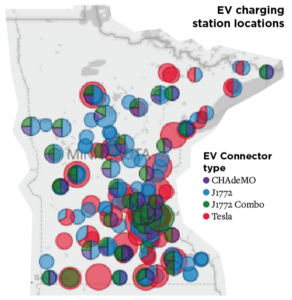Getting Charged Up About Electric Vehicles
By Trisha Duncan
Renewable energy goals are top of mind for many Minnesota cities, driven by the urgent need to address climate change. One emerging strategy for local governments, businesses, schools, and other entities to meet their clean energy goals is a transition from gasoline-powered to all electric vehicles (EVs).
They’ve been around since 1835
EVs are a hot topic today. With only 1% of the market, EVs might seem like a relatively new invention. Would you be surprised to learn that the first EV in the United States was developed in about 1835 by Thomas Davenport, a blacksmith from Vermont?

At the time, EVs lost out to gasoline- powered vehicles because they had a shorter driving range and higher purchase price than those fueled by gasoline. In 1912, an EV cost nearly three times as much as a gasoline-powered car, while expanding oil production in Texas made gasoline a cheap fuel.
More than 100 models
Today, the picture is different. More than 100 EV models offer a wide range of features, with many models available to consumers starting under $30,000. According to the Minnesota Department of Transportation, there were nearly 24,000 battery electric vehicles and plug-in hybrid electric vehicles in the state as of Dec. 31, 2021, with 1,259 public charging stations to support them. This number is only expected to grow in the coming years.
EVs reduce carbon and other emissions, require less maintenance, and lower fuel costs. In addition, charging EVs at home overnight is a great way to use excess wind power on the electric grid, costing customers the equivalent of less than $1 per gallon of gasoline.
Range anxiety
One persistent barrier to the growth of EV sales is consumer fear about running out of power on the road, also known as range anxiety. To support a growing EV market, the number of public charging stations will have to increase. Businesses, energy companies, and local governments are partnering with the State of Minnesota to expand the network of stations.
Expanding access to charging stations will help the state reach its goal of having 20% electric vehicles by 2030.
Building out the public charging network will provide more options for individuals to charge their vehicles on the go, address gaps in the charging network, and increase equity in transportation electrification. A significant expansion of access to affordable, public fast-charging stations will help Minnesota reach its goal of having 20% electric light-duty vehicles by 2030.
Of course, consumer automobiles aren’t the only gas-powered vehicles on the road. An important part of the plan to reduce carbon emissions from the transportation sector is to increase the number of electric trucks and cars used by businesses and government agencies to deliver products and services, collect trash, and transport people. A growing number of businesses and transit lines are on their way to replacing their entire fleet of vehicles with EVs as quickly as possible.
While no one can say that the road to replacing gas-powered vehicles will be without a few bumps, the entire automotive industry is driving steadily in that direction.
Trisha Duncan is director of Minnesota Community Relations at Xcel Energy (mn.my.xcelenergy.com/s/). Xcel Energy is a member of the League’s Business Leadership Council (lmc.org/sponsors).

